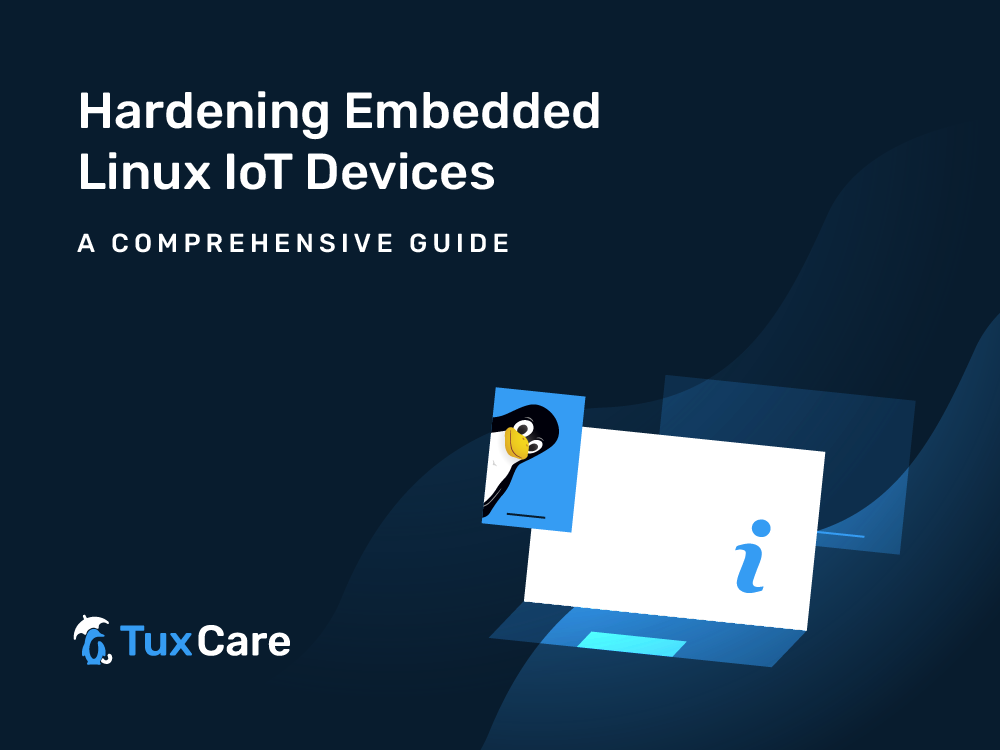Hardening Embedded Linux IoT Devices: A Comprehensive Guide
- Embedded systems often operate on specialized hardware with limited processing power, memory, and storage.
- Many embedded Linux IoT devices collect and transmit sensitive data. Hardening them reduces the risk of breaches that could expose this data.
- TuxCare’s live patching for IoT devices eliminates downtime concerns and streamlines the patching process, ensuring a secure and efficient IoT environment.
Embedded systems are everywhere – from smart thermostats in your home to industrial sensors in factories. But with this growing presence in the interconnected world of IoT (Internet of Things), these devices become attractive targets for attackers. Ensuring the security of embedded Linux systems is paramount to safeguarding the sensitive data they collect and transmit.
This article explores the process of hardening embedded Linux IoT devices, providing practical steps, essential tools, and methodologies to fortify your systems against potential threats.
Understanding Embedded Systems
Before we dive into the hardening techniques, it’s essential to understand the fundamentals of embedded systems. An embedded system is a small computer system designed to perform a specific task within a larger device. Embedded systems are present in devices like smartwatches, medical devices (like pacemakers, insulin pumps, and glucose monitors), factory robots, drones, traffic light control systems, and many more.
Unlike traditional desktop or server environments, embedded systems have limited resources. They often operate on specialized hardware with limited processing power, memory, and storage. Despite these hurdles, embedded systems must function reliably in diverse operating conditions – making security hardening even more critical.
The surge in embedded systems has fueled the adoption of Linux as the preferred operating system. Its open-source nature, offering customizability and cost-effectiveness, gives it a significant advantage over traditional Real-Time Operating Systems (RTOS). Furthermore, Linux’s ability to run on various Single-Board Computers (SBCs) and processors makes it attractive to both open-source enthusiasts and industrial users. However, this very advantage – its open-source nature – also presents a significant security challenge.
The Importance of Hardening
Why is hardening essential for embedded Linux IoT devices? Simply put, it’s about minimizing attack surfaces and fortifying defenses against potential threats. These devices, often deployed in remote or hostile environments, face a myriad of risks, including:
Unauthorized access: Hackers may exploit vulnerabilities to gain unauthorized access to sensitive data or control over the device.
Denial of Service (DoS) attacks: Malicious actors may flood the device with excessive traffic, rendering it unresponsive or causing operational disruptions.
Data breaches: Weak security measures could expose confidential information, compromising user privacy and regulatory compliance.
Malware and exploits: Without proper defenses, embedded systems are susceptible to malware infections and exploitation of known vulnerabilities.
The primary goal of hardening is to protect the system and its resources from unauthorized access or disruption that could come in the form of denial-of-service attacks. This goal is sometimes broken down into several sub-goals to better define what is required to achieve a high level of security. The sub-goals include: protecting the system’s data, ensuring the availability of the system and its resources, and controlling what can or cannot be done with the system’s resources.
Practical Steps for Hardening Embedded Linux IoT Devices
Now let’s get into the practical aspects of hardening your embedded Linux system. Here are some key strategies:
Keep Software Up to Date: Update the kernel, firmware, and software packages on a regular basis to address known vulnerabilities. Default package managers like apt or dnf facilitate the update process.
Secure Network Communications: Make use of SSL/TLS protocols to encrypt network traffic to prevent eavesdropping and tampering. Deploy tools like OpenSSL or OpenSSH to establish secure communication channels.
Firewall Configuration: Set up firewall rules so that only necessary connections are allowed and that both incoming and outgoing traffic are restricted. Tools like iptables or ufw (Uncomplicated Firewall) can be used to enforce firewall policies effectively.
Role-Based Access Control (RBAC): Implement RBAC mechanisms to assign privileges and restrict access based on user roles. Using programs like Security-Enhanced Linux (SELinux) improves fine-grained control over system permissions.
Minimize the Attack Surface: System administrators can disable unnecessary services and remove unused packages and dependencies to reduce the attack surface. Tools like systemctl allow users to control Linux services.
User Accounts: Enforce the use of complex passwords for all user accounts and implement multi-factor authentication (MFA) to strengthen authentication processes. Additionally, consider having limited user accounts with restricted privileges and deleting unnecessary accounts.
Secure Boot Process: Enable secure boot mechanisms to ensure the integrity of the boot process and prevent unauthorized modifications to the bootloader and kernel. For secure booting, system administrators can utilize technologies such as Trusted Platform Module (TPM) or UEFI Secure Boot.
Live Patching Embedded Linux IoT Devices
The conventional patching method often involves a system reboot, resulting in downtime and service disruption. Due to this, it is impractical for critical systems that require high availability and cannot go offline for even a small amount of time. This is where live patching becomes crucial. Live patching is the modern approach to patching where patches are applied while systems are running.
TuxCare’s KernelCare IoT live patching solution offers automated vulnerability patching for embedded Linux IoT devices without needing to restart or take them down. It ensures your connected devices keep running smoothly throughout the patching process. This significantly reduces the window of vulnerability and the risk of cyberattacks that exploit known weaknesses.
Final Thoughts
Hardening embedded Linux IoT devices is an ongoing process that requires vigilance, expertise, and proactive measures. By implementing the practical steps outlined in this guide and leveraging essential tools, you can enhance the security posture of your embedded systems, mitigate potential risks, and safeguard critical assets against evolving threats.



 Documentation
Documentation Login
Login




